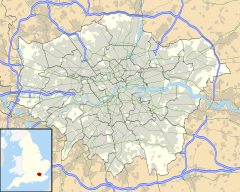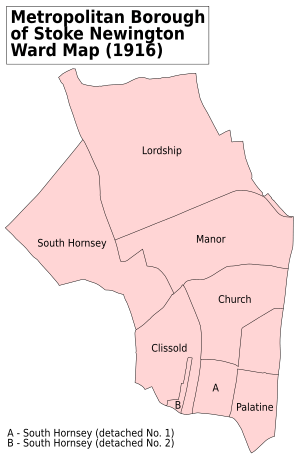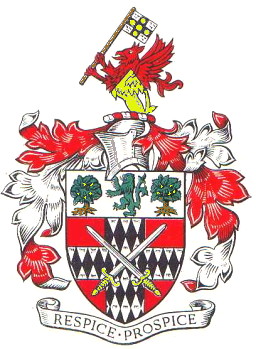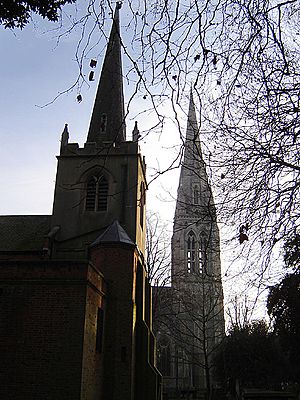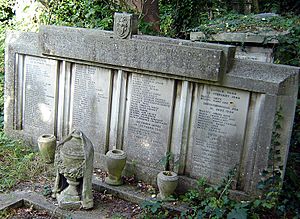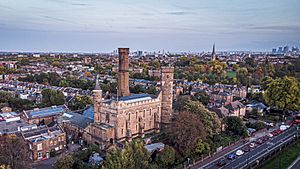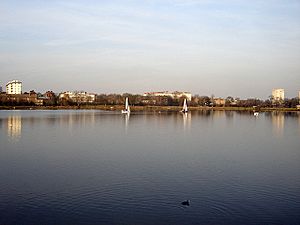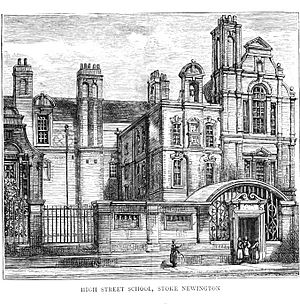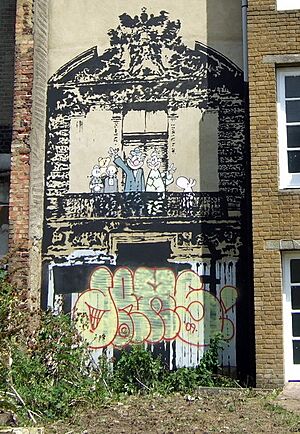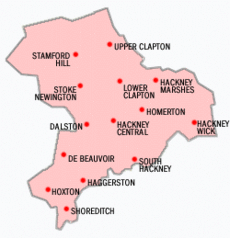Stoke Newington facts for kids
Quick facts for kids Stoke Newington |
|
|---|---|
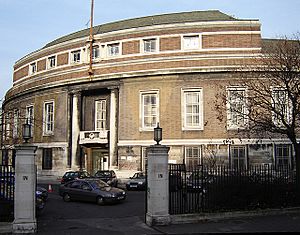 Stoke Newington Town Hall, built 1935–37 for the Metropolitan Borough of Stoke Newington |
|
| OS grid reference | TQ3386 |
| • Charing Cross | 5 mi (8.0 km) SW |
| London borough | |
| Ceremonial county | Greater London |
| Region | |
| Country | England |
| Sovereign state | United Kingdom |
| Post town | LONDON |
| Postcode district | N16 N4 |
| Postcode district | E8 |
| Dialling code | 020 |
| Police | Metropolitan |
| Fire | London |
| Ambulance | London |
| EU Parliament | London |
| UK Parliament |
|
| London Assembly |
|
Stoke Newington is an area in the northwest part of the London Borough of Hackney, England. It is about 5 miles (8 kilometers) northeast of Charing Cross, a central point in London. The area gets its name from the ancient parish of Stoke Newington.
Historically, Stoke Newington Church Street kept its unique village feel. In 1953, writer Nikolaus Pevsner even said it was hard to believe the district was part of London at all.
Contents
- What are the Boundaries of Stoke Newington?
- How Stoke Newington is Governed
- History of Stoke Newington
- Green Spaces in Stoke Newington
- Water Reservoirs
- People in Stoke Newington
- Schools in Stoke Newington
- Buildings and Art in Stoke Newington
- Getting Around Stoke Newington
- Fun and Entertainment in Stoke Newington
- Famous People from Stoke Newington
- See also
What are the Boundaries of Stoke Newington?
The London Borough of Hackney was created in 1965. It joined three older areas: Hackney, Stoke Newington, and Shoreditch. These older areas, called Metropolitan Boroughs, had been around since 1899. Their names and borders were based on even older areas from the Middle Ages called parishes.
Unlike some other London areas, Stoke Newington has had mostly the same borders for a long time. However, many people now think of Stoke Newington as stretching further east. This includes parts of the old Hackney area.
Old Borders
The old Metropolitan Borough of Stoke Newington mostly used the same borders as the ancient parish. Its eastern border followed the A10 road. This road is known as Stoke Newington High Street and Stoke Newington Road.
The northern and western borders of Stoke Newington are now the northwest borders of the modern London Borough of Hackney. These old borders included the small village of Stoke Newington. They also included part of Newington Green. However, they did not include Stoke Newington Common or Stoke Newington railway station.
Modern View of the Area
Today, many people think Stoke Newington extends east of the A10 road. This includes areas like West Hackney. It also includes Stoke Newington railway station and Stoke Newington Common.
Because of this, Stoke Newington is often linked with the N16 postcode. But a large part of western Stoke Newington is actually in the N4 postcode area.
How Stoke Newington is Governed
History of Local Government
The land of Stoke Newington was once a large estate, or Manor. It was owned by the Diocese of London, which is part of the Church of England. The Manor is mentioned in the Domesday Book of 1086 as Neutone. It was part of Middlesex county. The Domesday Book also shows that St Paul's Cathedral owned the Manor before and after the Norman Conquest. This Manor helped provide money for the cathedral's work.
The Ancient Parish of Stoke Newington was set up to serve the Manor's area. Its borders were likely set by the 1180s. From the Tudor period, parishes also took on civil duties. This included helping the poor under the Poor Law of 1601.
In the 17th century, the area was divided. Stoke Newington became part of the Finsbury division. Hackney, to the east, became part of the Tower division. Over time, the church and civil duties of parishes separated. Church parishes divided to serve more people. Civil parishes kept their old borders.
In 1855, the civil parishes of Hackney and Stoke Newington were joined. This was not popular, especially in Stoke Newington. After several tries, the two parishes became separate again in 1893.
In 1899, these parishes became Metropolitan Boroughs. Stoke Newington was smaller than planned for the new boroughs. There were ideas to join it with Hackney again. But these ideas were rejected. People remembered the "intolerable and endless fights" when they were forced together before. Parliament saw there was "great bad feeling" between the two areas.
Stoke Newington was allowed to be its own borough. Most of South Hornsey was added to it to make it bigger. This also helped connect parts of Stoke Newington that were separated.
Stoke Newington lost its independence in 1965. It joined with Hackney and Shoreditch. Together, they formed the new London Borough of Hackney.
Who Represents Stoke Newington?
Stoke Newington is part of the Hackney North and Stoke Newington constituency. This area has been represented by Labour MP Diane Abbott since 1987.
History of Stoke Newington
Early Times
Stoke Newington means 'new town in the wood'. It has been settled for hundreds of years. It was close to larger Saxon settlements near the River Lea. In the 1800s, people found that Stoke Newington Common and Abney Park Cemetery were once places where axes were made in the Stone Age. You can see some of these axes in the Museum of London.
In the Middle Ages and Tudor times, Stoke Newington was a tiny village. It was a few miles from London. Travelers often stopped there before going north on the Cambridge road (A10). At this time, St. Paul's Cathedral owned all the land. It brought in a small income for their work. In the 1600s, the Cathedral sold the Manor to William Patten. He became the first Lord of the Manor. You can see his initials 'WP' above the door of the old church near Clissold Park.
18th Century
A century later, the land went to Lady Mary Abney. She made the first detailed maps of the fields. She also started to create a park behind today's fire station on Church Street. She had help from her daughters and Isaac Watts. Because it was close to London, many Quaker and nonconformist families moved to the area during this century.
19th Century
In the early 1800s, London grew bigger. The Manor of Stoke Newington was sold off in pieces for building. The village slowly became part of London's expansion. By the mid-to-late 1800s, it was no longer a separate village.
Since it was on the edge of London, many large, expensive houses were built. These were for London's growing number of wealthy people. They could travel to the city center easily because of new railways and omnibuses. The first omnibuses were started in London in the 1820s by George Shillibeer. He first tested them as a school bus for a Quaker school called Newington Academy for Girls.
By the mid-1800s, Stoke Newington had the most Quakers in London. Many had moved from the city. A meeting house was built on Park Street (now Yoakley Road). The Anglican St Mary's Church, designed by Sir George Gilbert Scott, was built in 1854–58. It replaced the older parish church (also St. Mary's), which is still there across Church Street.
St Mary's Lodge on Lordship Road was built in 1843. It was the home of architect John Young. It is the last remaining large detached house built around that time for wealthy commuters. Gibson Gardens, an early example of good quality apartment buildings for working people, was built in 1880. It is still standing today.
Stoke Newington did well as a suburb in the late Victorian and Edwardian times. It had a good amount of wealth and local pride with its own government. This lasted until changes from the Second World War.
Early 20th Century
Between 1935 and 1937, the curved brick and stone Town Hall was built. It was for the Metropolitan Borough of Stoke Newington.
Second World War
During World War II, much of Stoke Newington was damaged by bombs. Many people lost their homes. However, the damage was less than in areas further south like Stepney or Shoreditch. The number of deaths was also low. Almost three-quarters of civilian deaths happened in one incident. On October 13, 1940, a crowded shelter at Coronation Avenue was directly hit. A memorial to all residents who died in the air raids is in Abney Park Cemetery.
Most of the old buildings in the heart of Stoke Newington survived. Two important exceptions were the grand St James's Church and St Faith's Church. Both were so badly damaged that they were torn down. St James's was replaced by a smaller church, St Paul's, after the war.
After the War
After the war, many damaged homes were torn down. New, large housing estates were built. Much of this building was planned by Frederick Gibberd.
21st Century
Today, Stoke Newington is a very multicultural area. It has large Asian, Irish, Turkish, Jewish, and Afro-Caribbean communities. Many new groups, like Polish and Somali immigrants, also live here.
Stoke Newington has become more modern and popular. This is also true for nearby areas like Newington Green and Dalston. Church Street has many independent shops, pubs, bars, and cafes.
In 2022, local businesses formed the Stoke Newington Business Association. They launched "See you in Stokey," a website about the area.
Green Spaces in Stoke Newington
In the north of the area is the large West Reservoir. It is no longer used for water storage. Now, it is open for fun activities and surrounded by green space. At the entrance is the Castle Climbing Centre. This building was once a water pumping station. It was designed to look like a tall Scottish castle.
South of these facilities is Clissold Park. It has a small zoo, a bird enclosure, and Clissold Mansion. This mansion was built in the 1790s for Jonathan Hoare, a local Quaker.
East from here, past the two St Mary's churches, is Abney Park Cemetery. This is one of London's most beautiful Victorian cemeteries. Many 19th-century non-conformist ministers are buried here. William Booth, who started the Salvation Army, is also buried here. It is now a nature reserve. In 2009, Abney Park was listed as a historic park at risk of neglect.
Across the high street to the east is Stoke Newington Common. It has many different types of trees planted there.
Water Reservoirs
Since the 1500s, Stoke Newington has helped supply water to London. The artificial New River runs through the area. It still helps provide water for London. The river path, called the New River Path, can be walked north to its source near Hertford.
Stoke Newington East and West Reservoirs were built in 1833. They held water before it was cleaned. Water is now sent from here to the Lee Valley Reservoir Chain for cleaning.
The West Reservoir is now a place for fun. You can go sailing, canoeing, and do other water sports there. The old filter house on its western edge is now a visitor center with a café. You can see some old water machinery inside. The pumping station at the reservoir gates was built in 1854–56. It looks like a castle. It is still used as a pumping station for the Thames Water Ring Main.
Besides these water facilities, Clissold Park has two large lakes. Many water birds live there, and also some terrapins. These lakes are thought to be old clay pits. They are all that is left of the Hackney Brook, a river that once flowed through Stoke Newington. The lakes are now fed by the main water supply, not the old brook.
People in Stoke Newington
At the time of the 2011 census, there were 13,658 people living in Stoke Newington Central ward. Most residents were White (63.1%). Black people made up 16.6% of the population, and Asian people were 9.9%.
About 33.8% of the ward was Christian. 11.1% were Muslim, and 3.2% were Jewish. Many people (39%) said they had no religion.
Schools in Stoke Newington
Primary Schools
- Benthal Primary
- Betty Layward Primary
- Grasmere Primary
- Grazebrook Primary
- Holmleigh Primary
- Princess May Primary
- Jubilee Primary
- Simon Marks Jewish Primary School
- Sir Thomas Abney
- Saint Mary's Church of England Primary
- Saint Matthias Church of England Primary
- William Patten Primary
Secondary Schools
- Stoke Newington School
- Our Lady's Catholic High School
- Skinners' Academy
- Tawhid Boys School
Buildings and Art in Stoke Newington
Stoke Newington has many interesting buildings. One, St Matthias Church, is a Grade I listed building, meaning it is very important. There are also several Grade II* and Grade II buildings.
- Grade I Buildings
- St Matthias Church, Wordsworth Road
- Grade II* Buildings
- 187–191 Stoke Newington High Street
- 81/83 Stoke Newington Church Street
- 85/87 Stoke Newington Church Street
- St Mary's Old Church
- St Mary's New Church
- Clissold House, Clissold Park
- St Andrew's Church, Bethune Road
- The Castle Climbing Centre, Green Lanes
- Grade II Buildings
- Stoke Newington Town Hall (won an award for its restoration in 2010)
- Abney Park Chapel
- Newington Green Unitarian Church
- 113 Stoke Newington Church Street, where writer Anna Laetitia Barbauld once lived
- Sanford Terrace
Many Grade II listed properties are on Stoke Newington Church Street, the historic center. Also, Albion Road and Clissold Road have many listed homes.
Near The Lion pub, local resident Sofie Attrill allowed the band Blur to create publicity for their 2003 song "Crazy Beat". The album art was done by graffiti artist Banksy. The single featured a funny image of the British Royal Family. This was painted as a mural on the building. By 2009, it was a tourist spot. Hackney Council wanted to remove all graffiti. They tried to contact the owner to remove the artwork. They started painting over it with black paint, but stopped after partly covering it.
Getting Around Stoke Newington
 |
Manor House | Stamford Hill | Upper Clapton |  |
| Finsbury Park | Upper Clapton | |||
| Newington Green | Dalston | Lower Clapton |
The closest London Underground station is Manor House. It is about 1.5 miles (2.4 km) away on the Piccadilly line.
Stoke Newington has several train stations on the Lea Valley Lines (going south to north):
Many bus routes serve the area, including 67, 73, 76, 106, 141, 149, 243, 276, 341, 393, and 476. Night buses N73 and N76 also run. Routes 149, 243, and 341 run 24 hours a day.
Fun and Entertainment in Stoke Newington
Stoke Newington is known for its pubs and bars. It has a lively music scene, including contemporary jazz. You can also find open mic comedy sessions. The Vortex Jazz Club used to be on Church Street but has now moved to Dalston.
Since 2010, Stoke Newington has had its own literary festival. It celebrates the area's history of writers and radical thinkers. It happens in early June at different places around the area. Time Out magazine described it as "Just like Hay-on-Wye, but in Hackney."
A Stoke Newington music festival started in 2015. It takes place in late October at various venues. Famous musicians like Thurston Moore of Sonic Youth have performed there.
Famous People from Stoke Newington
Historical Figures
- Lady Mary Abney (1676–1750), inherited the land and ordered the first maps.
- William Allen (1770–1843), a Quaker, helper of others, scientist, and leader against slavery. He lived most of his life in Stoke Newington.
- Anna Laetitia Barbauld (1743–1825), a writer and poet, lived at 113 Stoke Newington Church Street.
- Joseph Conrad (1857–1924), author of Heart of Darkness, lived in Stoke Newington.
- Daniel Defoe (c. 1660–1731), a famous writer, was born and lived on Church Street.
- Charles Fleetwood (1618–1692), a general during the English Civil War, lived in Stoke Newington.
- John Howard (1726–1790), who started the prison reform movement, lived in Stoke Newington.
- Joseph Jackson Lister (1786–1869), a Quaker and scientist. He invented the modern microscope. He lived in Stoke Newington when he was first married.
- Edgar Allan Poe (1809–1849), a famous American writer. He went to school on Church Street around 1818.
- Isaac Watts (1674–1748), a religious writer and hymnwriter. He lived and died at Abney House.
People from the 20th and 21st Centuries
- Diane Abbott, MP for Hackney North and Stoke Newington. She was the first black woman MP.
- Bad Manners is a band from Stoke Newington. They formed at Woodberry Down comprehensive school in 1976.
- Marc Bolan (born Mark Feld), a musician. He lived at 25a Stoke Newington Common until he was 15.
- Eric Bristow, a five-time world darts champion. He was born in Stoke Newington.
- Saffron Burrows, an actress, grew up in Stoke Newington.
- Asa Butterfield, an actor, went to Stoke Newington School.
- Paloma Faith, a singer and actress, grew up in Stoke Newington.
- Professor Green, (real name Stephen Manderson), a rapper, went to Stoke Newington Secondary School.
- Stewart Lee, a comedian and writer, lives in Stoke Newington.
- Ken Livingstone, former Mayor of London. He represented Stoke Newington on the Greater London Council from 1977 to 1981.
- Zöe Lucker, an actress, lives in Stoke Newington.
- Jean Marsh, an actress and writer, was born in Stoke Newington.
- Warren Mitchell, an actor, was born in the district.
- Pauline Quirke, an actress, grew up in Stoke Newington.
- Maverick Sabre, a singer-songwriter, was born in Stoke Newington.
- Barbara Windsor, an actress from EastEnders, grew up in Stoke Newington.
See also
 In Spanish: Stoke Newington para niños
In Spanish: Stoke Newington para niños


